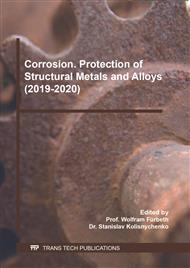p.3
p.11
p.23
p.31
p.43
p.51
p.58
p.67
p.75
Effect of Sol-Gel Film on the Corrosion Resistance of Low Carbon Steel Plate
Abstract:
To improve the corrosion resistance on Q235 low carbon steel, in this paper, tetraethyl orthosilicate (TEOS), N-dodecyl trimethoxysilane and γ-(2,3-epoxypropoxy) propytrimethoxysilane (KH560) were used to make organic-inorganic hybrid sol-gel film. Cross cut test adhesion method, neutral salt spray test, electrochemical test and film protective efficiency were taken to value the corrosion resistance property. The corrosion topography was studied by optical microscope. In addition, potentiodynamic polarization, electrochemical impedance spectroscopy (EIS) curves and equivalent electric circuit fitting were used to analyze the corrosion mechanism. The cross cut adhesion of sol-gel film can reach 1 class and the protection class can attain 5 class after 72 hours neutral salt spray test. According to the potentiodynamic polarization curve analysis, the corrosion potential of sol-gel film coating sample after 0.5 hours immersion was -0.46 V (vs. SCE) on the 0.1 Hz, and its corrosion current density was 4.74×10-7 A·cm-2. The corrosion potential of bare Q235 low carbon steel plate after 0.5 hours immersion was -0.78 V (vs. SCE) on the 0.1 Hz, and its corrosion current density was 4.75×10-6 A·cm-2. The impedance value on 0.1 Hz (|Z|0.1Hz) (1.27×106 Ω·cm2) of sol-gel film coating sample was more than three orders of magnitude higher than the value of the low carbon steel plate. Even dipping in 3.5 wt. % NaCl for 72 hours, the |Z|0.1Hz value of sol-gel coating sample was still one order of magnitude higher than the low carbon steel plate with 0.5 hours immersion. Sol-gel film with excellent adhesion can significantly improve the corrosion resistance of low carbon steel plate. Sol-gel film can increase the protection efficiency of low carbon steel plate by 90%.
Info:
Periodical:
Pages:
43-50
Citation:
Online since:
April 2020
Authors:
Price:
Сopyright:
© 2020 Trans Tech Publications Ltd. All Rights Reserved
Share:
Citation:



